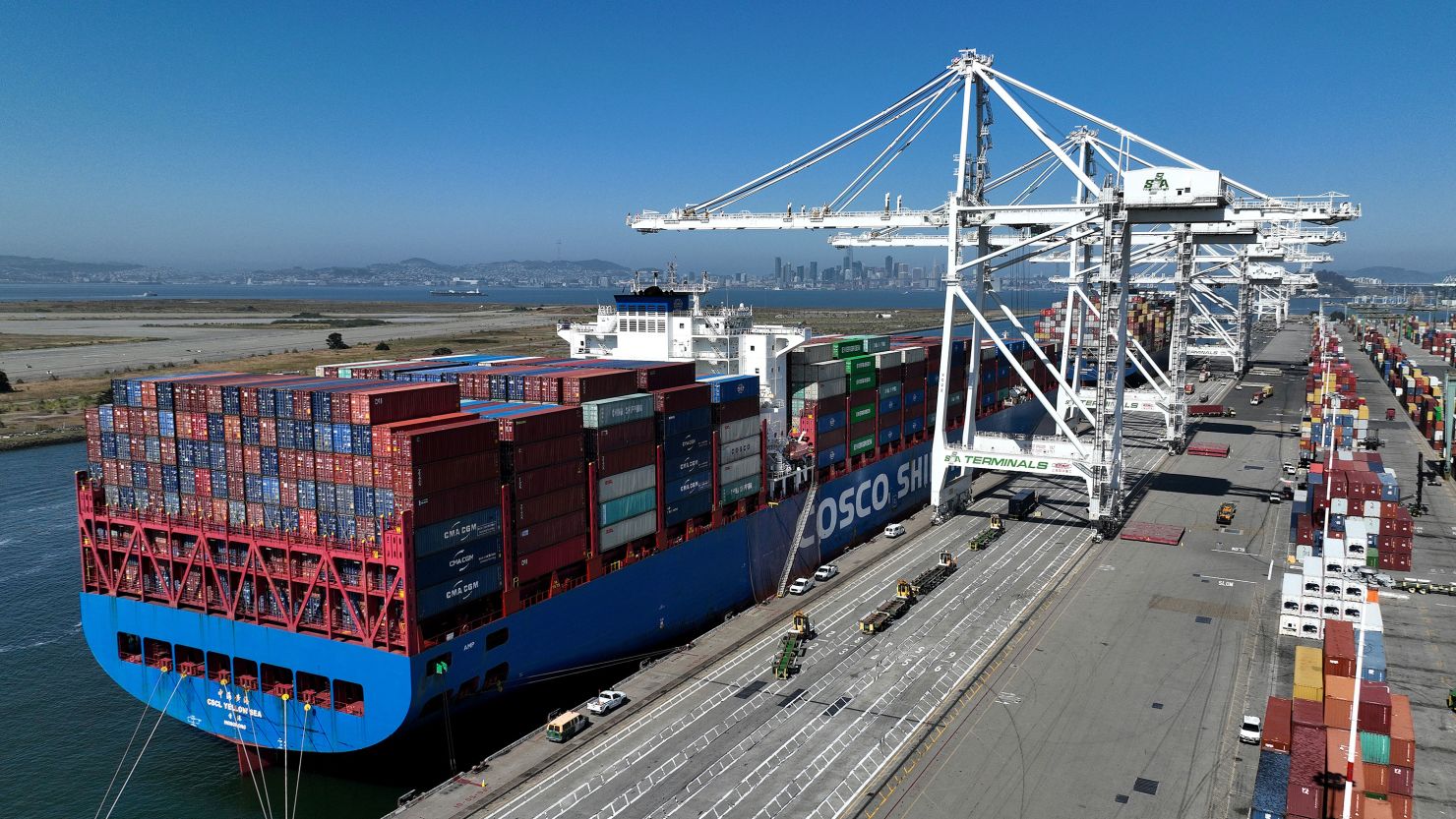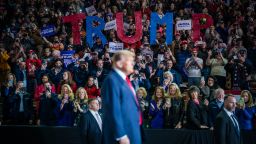When former President Donald Trump was in the White House, he proudly referred to himself as a “Tariff Man” – and he has no intention of retiring that self-proclaimed title if reelected.
Trump has repeatedly floated the idea of imposing a 10% tariff on every good coming into the US, as well as a tariff upward of 60% on all Chinese imports if he regains the presidency. On Saturday, during a campaign rally, he promised a “100% tariff” on cars made outside the US and warned of a “bloodbath” for the American auto industry if he doesn’t get reelected.
Starting in 2018, Trump put new tariffs of up to 25% on washing machines, solar panels, steel and aluminum, as well as many Chinese-made goods including baseball hats, luggage, bicycles, TVs and sneakers – and President Joe Biden has left most of these tariffs in place.
There could be many different reasons for imposing tariffs. Biden’s top trade official recently called them “a tool for remedying unfair trade.” But tariffs don’t bring in revenue from foreign countries, as Trump often claims. It’s American importers – not China or any other foreign country or company – that pays the tariffs.
“A tariff is just a form of a tax,” said Erica York, a senior economist and research director at the conservative-leaning Tax Foundation.
“It’s the US purchaser, the importer of those goods, that makes the physical payment to the US government,” she added.
Americans have paid more than $230 billion to date for tariffs that Trump imposed on imported solar panels, steel and aluminum and Chinese-made goods, according to US Customs and Border Protection. More than half of the duties have been collected during the Biden administration.
Despite the cost, Trump’s tariffs were a political success, according to one working paper published recently by economic researchers.
“Residents of regions more exposed to import tariffs became less likely to identify as Democrats, more likely to vote to reelect Donald Trump in 2020, and more likely to elect Republicans to Congress,” they wrote.
Many people across the political spectrum agree that China uses unfair trade practices, and they like the idea of trying to get Beijing to change its ways. Plus, Trump gave farmers – who were hit hard by retaliatory tariffs – $23 billion in direct aid payments in 2018 and 2019 to help soften the blow of trade-related losses.
The protection provided by tariffs typically comes with some trade-offs. Here’s how Trump-era trade policies have impacted the economy.
Americans pay the tariffs
When the US puts a tariff on an imported good, the cost of the tariff comes directly out of the bank account of an American importer when the foreign-made product arrives at the port.
It’s possible that some foreign manufacturers lowered their prices to stay competitive in the US market. But several studies have suggested that US companies and consumers are bearing the brunt of the tariff cost.
In a 2023 study, the US International Trade Commission said that “U.S. importers bore nearly the full cost of these tariffs.” The independent federal agency, which provides analysis to the White House and Congress, estimated that prices increased by about 1% for each 1% increase in the tariffs on steel, aluminum and Chinese-made goods.
Once the importing company pays the tariff, it can decide to eat the cost or pass all or some of it along to the buyer of its goods – whether that’s a retailer or a consumer. For that reason, it’s more difficult to determine how much of the tariff cost actually ends up being paid indirectly by American households. But one study, published in 2020, found that tariffs on washing machines raised the median price of one by about $86.
Still, Trump’s tariffs were put on a relatively small share of all the goods consumers purchase. Several studies show they only marginally contributed to US inflation that followed the Covid-19 pandemic.
More jobs were lost than created
Trump’s tariffs helped create some jobs, but even more were lost in the wake of his trade wars.
Overall, the US economy lost jobs due to the tit-for-tat tariffs that took effect during the Trump administration, according to several studies, like one from the Tax Foundation and another from the US-China Business Council, a nonprofit whose goal is trade promotion.
A study from St. Louis Federal Reserve economists provides more evidence that tariffs played a role in job losses. It showed states more exposed to US tariffs on imports from China experienced “lower increases or even decreases” in employment and output between 2018 and 2019.
Tariffs were meant to boost US manufacturers, but they lost jobs too
Trump’s tariffs were imposed, in part, to boost the US manufacturing sector – but that industry suffered a loss of jobs as well, according to at least one study.
Federal Reserve economists found a net decrease in manufacturing employment due to the tariffs in 2019. That’s mostly because goods became more expensive to US businesses and consumers, and retaliatory tariffs put on American-made goods made other US manufacturers less competitive when selling abroad.
Take this hypothetical example: Trump’s tariffs made foreign steel more expensive to US consumers – so much so, that some may switch to an American-supplier of steel. This is good for the US steel producer.
But now, US manufacturers that use steel to make their goods are likely paying a premium for it. This makes it more expensive for some American manufacturers to produce their own goods and hurts their bottom line.
“While one may view the negative welfare effects of tariffs found by other researchers to be an acceptable cost for a more robust manufacturing sector, our results suggest that the tariffs have not boosted manufacturing employment or output, even as they increased producer prices,” the Federal Reserve economists wrote.
What’s more, the jobs that were created came at a high cost. Each new job in the steel industry was expected to cost steel buyers an extra $650,000, according to an analysis from the Peterson Institute for International Economics.
Getting China to play fair
Trump used tariffs as a negotiating tactic, meant to hurt China’s economy and pressure Beijing to agree to a new deal that addresses unfair trade practices, such as intellectual property theft and forced technology transfers. Business leaders across the country, as well as lawmakers on both sides of the aisle, tend to agree that China’s trade policies need to be addressed.
Trump’s tariffs helped bring Chinese President Xi Jinping to the negotiating table. The two came to a truce in January 2020, signing what’s known as the Phase One agreement. It reduced the rate of some of the tariffs, and China agreed to increase its purchases of US goods and agricultural products – setting a target of buying $200 billion more than it did before the trade war began.
But China fell well short of that commitment – which the Biden administration has suggested is one of the reasons it has kept tariffs on Chinese-made goods in place.
While the text of the agreement included paragraphs that addressed Chinese intellectual property theft, it ultimately had no meaningful effect, said Derek Scissors, an economist and senior fellow at the American Enterprise Institute, a right-leaning think tank.
“They did not have a monitoring mechanism, which is the absolutely critical part of IP if you want to have a deal with the Chinese. They didn’t even try,” Scissors said.
A phase two agreement was never reached between the US and China under either the Trump or Biden administrations. In September, the two countries launched an Economic Working Group and a Financial Working Group that bring Washington and Beijing officials together for regularly scheduled meetings to discuss their economies.


